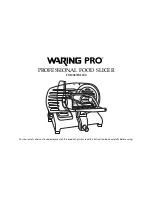
16
15
Food safety
Cooking sous vide is just as safe as traditional cooking methods. Some people
see the relatively low cooking temperatures used in sous vide cooking and worry
that this will make their food unsafe to eat. Luckily, that’s not the case. Although
higher cooking temperatures will pasteurize your food more quickly, those high
temperatures also make your food dry and unappetizing.
Not all food needs to be pasteurized in order to be considered safe to eat. The
interior of a steak or other intact animal muscle, for example, is considered a sterile
environment: if there were pathogens inside the meat, the animal would have
appeared sick. However, we do want to destroy any pathogens that may have
gotten onto the surface of the meat. Searing after cooking sous vide takes care
of this risk, and adds a delicious crust!
Poultry is no different than other meats. To reduce the risk of illness due to
surface contamination, we include additional cooking time in all of our poultry
recommendations to ensure pasteurization, so searing your poultry is optional.
Fish pose a different set of food-safety considerations. The times and
temperatures that we recommend for fish create the best-tasting results, but do
not necessarily ensure pasteurization.
As with any lightly cooked food, there is always some risk of foodborne illness,
and the amount of risk you’re willing to accept is a personal choice. Although food
safety is a complex and nuanced topic, the best way to keep your risks as low as
possible is to follow good sourcing and safe handling practices.
Consuming raw or undercooked meats, poultry, seafood, shellfish,
eggs, or unpasteurized milk may increase your risk of foodborne illness.
Further Reading:
Modernist Cuisine
Vol 1. Chapter 3
Frequently asked questions
Q Is sous vide cooking just for fancy chefs?
A Not at all! Cooking sous vide is easy and practical for home cooks of all levels.
The Sansaire cooks foods evenly from edge to edge, to exactly the doneness
you want. And because foods won’t overcook while they hang out in the water
bath, dinner is ready when you are. Whether you’re preparing a multicourse
dinner party or cooking a weeknight meal, cooking sous vide alleviates the
stressful, split-second timing required by traditional cooking.
Q Is sous vide the same as “boil-in-a-bag”?
A If you’ve endured the dry, bland horror of boiled meat, we can understand
why the idea of cooking food in sealed bags may induce a knee-jerk reaction.
The key difference is that sous vide cooking uses much lower temperatures to
cook your food—temperatures that are precisely chosen to produce the juiciest,
most flavorful results. As meat gets hotter, the muscle fibers begin to contract,
causing the meat to plump and firm slightly. If the meat gets too hot—as in the
boiling scenario, the muscle contraction actually squeezes the juices out of the
meat, leaving you with a tough, tasteless mess. Sous vide cooking temperatures
are well below this threshold, ensuring that your proteins are always properly
cooked.
Q Is it safe to cook in plastic bags?
A Bags made of polyethylene and polypropylene that are labeled BPA-free are
perfectly safe for sous vide cooking. Polyethylene and polypropylene have
been used in laboratory settings for decades, and if they leached any chemicals,
those chemicals would have thrown off the results of sensitive experiments.
Always avoid bags containing polyvinyl chloride (PVCs) or those not labeled as
BPA-free. Most name-brand zip-top bags, as well as the bags sold for vacuum
sealing, will list their ingredients on the box.
Summary of Contents for SA15
Page 1: ...Sous Vide Cooking Guide...





























